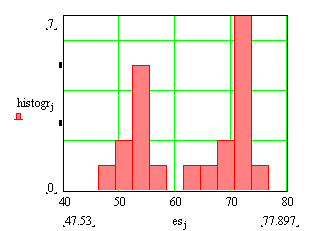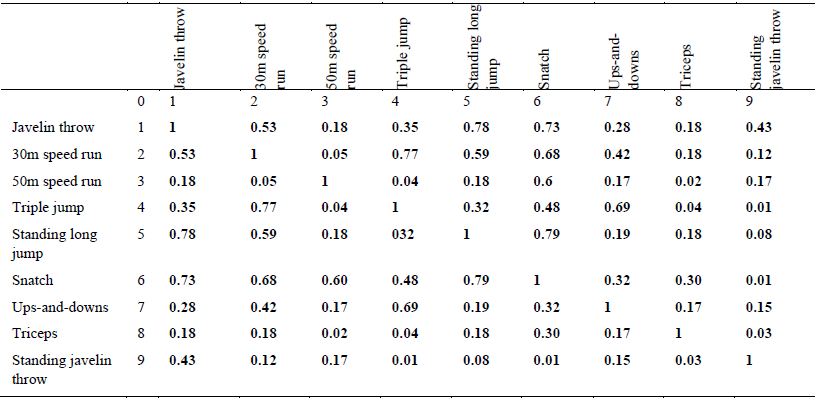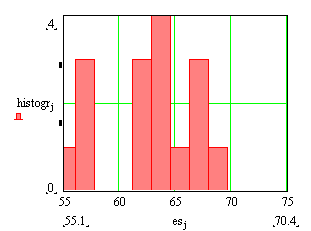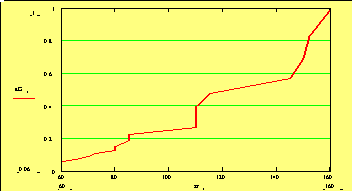Abstract
In high level sports, trials are essential for the performance planning and monitoring, for establishing the threshold reached and estimating performance. Controls must allow evaluating the adaptation level of major functions to the event-specific demands, the development stage of motor qualities and the technicality level. That is why they are in conformity with the effort specificity in the respective event, with the individual particularities related to age and gender, as well as with the motor structures characteristic to technical gesture. Starting from the hypothesis that, under certain conditions, the results obtained in the trials have relevant prediction power, there have been tested 18 male and female athletes, discus and javelin throwers. For all trials, the coefficients of correlation with the athletic discipline were calculated, the measurands were labelled and the graphs were interpreted. The research has revealed a divided sample of athletes, the fact that some trials correlate with one another, while others correlate with the competitive results, and that the progress rate is relatively constant for the changes in labelling. The final conclusion is that a small part of the trials imposed by the Romanian Athletics Federation are significant and provide information which argues an acceptable prediction of the results in the oncoming competition. In an antithesis, most of the trials have a very weak power of predicting the competitive results immediately after their application.
Keywords: Javelin throw, discus throw, trials, competition event, correlation
Introduction
In performance sports, trials must allow estimating the adaptation level of major functions to the
event-specific demands, assessing the development stage of motor qualities and also the technicality
level. Trials should correspond to the effort specificity in the respective event, to the individual
particularities related to age and gender, but also to the motor structures characteristic to that event.
Depending on the relevance of the trials or rather on their degree of statistical correlation with the
competitive result, prognosis can provide in advance some information on the results in the oncoming
competition (Anton, 2003).
Specialized literature shows that the interest in prognosis is greater than in diagnosis, which can be
explained by the economical and time management effects that the prognosis provides (Ivan, 2005).
of this paper is to deepen the data provided by specialized literature with reference to
the prognosis of competitive performances on the basis of relevant trials, because we are tempted to
think that most trials and controls are not appropriate to the athletic disciplines, preparation level,
picked moments, and that their prediction power is weak.
At the same time, we adhere to the idea that trials and controls will aim more and more at
anticipation and prediction, which is useful to high performance sports management. Prognosis is
based on the logical interpretation of causal links, not on the statistical interpretation of correlations.
This practical-applicative approach will validate or invalidate according to which the
trials and controls have a relevant prediction power, are correctly chosen and performed at appropriate
moments, in compliance with the provisions of the specialty federation.
Materials and methods
There were taken into consideration the best performances recorded in the competitive summer
season by 14 javelin throwers and 4 discus throwers. The respective performances were statistically
correlated with the results in the trials completed within no more than three weeks before the event.
Correlation may refer to any departure of two or more random variables from independence, but
technically, it refers to any of several more specialized types of relationship between mean values
(Wikipedia, 2015). Rank correlation coefficients measure a different type of relationship than the
Pearson product-moment correlation coefficient, and are best seen as measures of a different type of
association rather than as an alternative measure of the population correlation coefficient (Stuart and
Ord, 1994). We used Pearson’s correlation, which is “more sensitive to nonlinear relationships”
(Croxton, Cowden, & Klein, 1968: 625).
Competitive performances were labelled or tagged (using the grading system), graphically
represented and then interpreted. According to Gagea (1999: 110), any entity has one or many
characteristics… and each characteristic can be attached a category (grade, mark, score, label, value or,
in general, a subjective qualitative expression. The author has contributed to augmenting the specialty
lexicon with new terms, namely the measurable characteristics are called “measurands” and “labelling”
refers to assigning them a score, mark, grade, etc.
The subjects performed 6 common trials (30/50m speed run, standing long jump, standing triple
jump, barbell snatch, ups-and-downs with barbell, apparatus throw - javelin/discus from standing
position) and 5 specific trials (triceps - barbell pull from standing position, barbell push from lying on
back, forward shot put, backward shot put and 2.5kg discus throw from standing position).
Results
In the graph below, on the abscissa, the throwing distances were staggered from 40 to 80m for
javelin throw, and on the ordinate, the results were assigned values (scores/labels) from 1 to 7.
Histogram 1 emphasizes an obvious division between the samples of men athletes and women
athletes, reflecting the fact (which is actually normal) that their performances differentiate clearly. In
the case of men athletes (on the right side), the results comprised between low and moderate values are
more numerous compared to female athletes. The gap between average values and maximal
performance is also higher by 2 labels (tags) in the case of men athletes compared to women athletes.

The following graph shows the indices of correlation between trials and competitive throw. The
table highlights that only standing long jump and barbell snatch trials significantly correlate with
javelin throw. Some trials correlate between them, for instance barbell snatch with 30m sprinting and
standing long jump. Significance is calculated for a 95% confidence threshold.
Unfortunately, even knowing the value of trials highly correlated with competition, the estimation
of competitive throw cannot be mathematical, because, in this case, there are also added the
technicality characteristic to javelin throwing event, the mental factor and probably the environmental
(climatic) factor. In other words, a successful throw requires the synchronization of many parameters at
an optimal level. This reasoning is proved by the great variation in distance of the throws performed
during competition.

In a similar way, it was drawn the histogram of the results in discus throwing event: on the abscissa,
the throwing distances were staggered from 55 to 70m, and on the ordinate, the results were assigned
values (scores/labels) from 1 to 4. Histogram 2 highlights a smoother gap between the moderate and
maximal throws in both samples. At the same time, it shows that, between the values 1 and 4 on the
ordinate, the progress rate of performances is relatively the same, but not as sudden as for the javelin
throw. This aspect is also argued by the differences between throwing lengths in discus throw
compared to javelin throw.

In the table below, which shows the correlation indices between trials and competitive performance
in discus throw, it can be noted a significant correlation only with standing long jump, snatch and
standing throws. Run-up throws and standing throws being, in our opinion, consequences of the motor
qualities educated during training, the correlation between them appears as a natural fact and denotes
that their possible lack of correlation is strictly related to the run-up technique. Such situations aimed to
diagnose the technique are not very frequent and, according to us, standing throws should not be used
as trials in a predictive motor model.
In the discus throw too, as shown in the histogram below (Fig. 3), assigning some values (scores) to
the performances in snatch trial (on the abscissa, values comprised between 60 and 160kg, and on the
ordinate, 5 values) indicates that the progress rate is relatively the same for the changes in values.
The graph for barbell snatch trial reveals a relatively normal upward trend in both samples, the only
difference between genders being related to motor qualities, namely low values for the female sample
and high values for the male sample.

Discussions and conclusions
Statistical correlation is one of the analytical interpretation forms through which the resemblance of
variations for two or many series of data is estimated. According to Gagea (2000), correlation finds
how much the variation of two series of data resembles. The degree of resemblance is measured
(approximated) by means of the correlation coefficient or correlation ratio.
Trials included in the battery should cover, in terms of information, the main factors of the event.
Trials must not be closely correlated with one another, because they would become redundant,
providing similar information or useless information. To be relevant, trials must be correlated with the
sports event, but only the significant correlations, for which the correlation coefficient exceeds an
acceptable threshold (p = 0.05), can be interpreted.
It is known that only the data making part of the so-called “normal (Gaussian) distributions” can be
correlated statistically, or almost all measurements referring to motor qualities are normal distributions.
An exception is represented by the coordination abilities, which are rarely normal from the statistical
point of view.
We can conclude that a small part of the trials applied with the agreement of the Romanian Athletics
Federation are significant and provide information that argues an acceptable prediction of the results in
the oncoming competition. In an antithesis, most of the trials have a very weak power of predicting the
competitive results immediately after their application.
In high performance, the training management focused on energy saving requires to give up the
non-specific means which have no connection at all with the competitive event. It can be concluded
that appropriate trial for prediction is barbell snatch, which means that any significant increase
in the result for this event increases the chances to achieve a valuable performance in the oncoming
competition.
Although it does not result from our data, one can argue, with bibliographic references, that a series
of trials are not suitable either to the throwing events in general or only to certain events. For example,
30-50m sprint and standing triple jump for no type of throw, ups-and-downs and triceps for javelin
throw, barbell push from lying on back, forward shot put and backward shot put for discus throw.
References
Anton, M. (2003). Studiul performanței competiționale pe baza probelor de control relevante la aruncări
(Teză de doctorat). ANEFS, București.
Wikipedia. (2015). Correlation and dependence. Retrieved from
http://en.wikipedia.org/wiki/Correlation_and_dependence
Croxton, F. E., Cowden, D. J., & Klein, S. (1968). Applied General Statistics (3rd Ed.). Pitman and Sons Ltd.
Gagea, A. (1999). Metodologia cercetării ştiinţifice în educaţie fizică şi sport. Bucureşti: Editura Fundaţiei “România de Mâine”.
Gagea, A. (2000). Statistica computerizată în educație fizică și sport. București: Editura Ecologică. Ivan, C. (2005). Eficientizarea procesului de verificare/apreciere în proba de aruncare a suliţei; posibilităţi de prognoză a capacităţii de performanţă. Conferinţa Ştiinţifică Internaţională, ANEFS, Bucureşti.
Stuart, A., & Ord, K. (1994). Kendall’s Advanced Theory of Statistics (6th Ed.). (Vol. 1: Distribution Theory).
Wiley.
Copyright information

This work is licensed under a Creative Commons Attribution-NonCommercial-NoDerivatives 4.0 International License.
About this article
Publication Date
10 June 2016
Article Doi
eBook ISBN
978-1-80296-010-5
Publisher
Future Academy
Volume
11
Print ISBN (optional)
-
Edition Number
1st Edition
Pages
1-509
Subjects
Sports, sport science, physical education
Cite this article as:
Ivan, C., & Anton, M. (2016). The Trial-Performance Relationship in Javelin and Discus Throwing Events. In V. Grigore, M. Stanescu, & M. Paunescu (Eds.), Physical Education, Sport and Kinetotherapy - ICPESK 2015, vol 11. European Proceedings of Social and Behavioural Sciences (pp. 136-142). Future Academy. https://doi.org/10.15405/epsbs.2016.06.19

